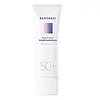What's inside
What's inside
 Key Ingredients
Key Ingredients

 Benefits
Benefits

 Concerns
Concerns

 Ingredients Side-by-side
Ingredients Side-by-side

Butyl Methoxydibenzoylmethane 3%
UV AbsorberHomosalate 15%
Skin ConditioningEthylhexyl Salicylate 5%
UV AbsorberOctocrylene 10%
UV AbsorberWater
Skin ConditioningStyrene/Acrylates Copolymer
Hydrated Silica
AbrasiveGlycerin
HumectantPolyglyceryl-6 Stearate
EmollientPolyglyceryl-6 Behenate
Emulsion StabilisingAcrylates/C12-22 Alkyl Methacrylate Copolymer
Polyester-8
Skin ConditioningEthylhexylglycerin
Skin ConditioningLysolecithin
EmulsifyingPhenoxyethanol
PreservativePullulan
Sclerotium Gum
Emulsion StabilisingTetrasodium Glutamate Diacetate
Tocopheryl Acetate
AntioxidantXanthan Gum
EmulsifyingButyl Methoxydibenzoylmethane 3%, Homosalate 15%, Ethylhexyl Salicylate 5%, Octocrylene 10%, Water, Styrene/Acrylates Copolymer, Hydrated Silica, Glycerin, Polyglyceryl-6 Stearate, Polyglyceryl-6 Behenate, Acrylates/C12-22 Alkyl Methacrylate Copolymer, Polyester-8, Ethylhexylglycerin, Lysolecithin, Phenoxyethanol, Pullulan, Sclerotium Gum, Tetrasodium Glutamate Diacetate, Tocopheryl Acetate, Xanthan Gum
Arctium Lappa Root Extract
Skin ConditioningWater
Skin ConditioningDicaprylyl Carbonate
EmollientGlycerin
HumectantDibutyl Adipate
EmollientDiethylamino Hydroxybenzoyl Hexyl Benzoate
UV FilterHydrogenated Polyisobutene
EmollientDipropylene Glycol
Humectant1,2-Hexanediol
Skin ConditioningNiacinamide
SmoothingEthylhexyl Triazone
UV AbsorberSilybum Marianum Seed Extract
Skin ConditioningSalvia Officinalis Leaf Extract
CleansingHouttuynia Cordata Extract
Skin ConditioningLeontopodium Alpinum Extract
Skin ConditioningJasminum Officinale Extract
MaskingLilium Tigrinum Extract
Skin ConditioningEthylhexyl Olivate
Skin ConditioningCetearyl Olivate
Sodium Acrylates Copolymer
Butylene Glycol
HumectantSorbitan Olivate
EmulsifyingPolyglyceryl-4 Oleate
EmulsifyingAdenosine
Skin ConditioningEthylhexylglycerin
Skin ConditioningTocopherol
AntioxidantDisodium EDTA
Arctium Lappa Root Extract, Water, Dicaprylyl Carbonate, Glycerin, Dibutyl Adipate, Diethylamino Hydroxybenzoyl Hexyl Benzoate, Hydrogenated Polyisobutene, Dipropylene Glycol, 1,2-Hexanediol, Niacinamide, Ethylhexyl Triazone, Silybum Marianum Seed Extract, Salvia Officinalis Leaf Extract, Houttuynia Cordata Extract, Leontopodium Alpinum Extract, Jasminum Officinale Extract, Lilium Tigrinum Extract, Ethylhexyl Olivate, Cetearyl Olivate, Sodium Acrylates Copolymer, Butylene Glycol, Sorbitan Olivate, Polyglyceryl-4 Oleate, Adenosine, Ethylhexylglycerin, Tocopherol, Disodium EDTA
Ingredients Explained
These ingredients are found in both products.
Ingredients higher up in an ingredient list are typically present in a larger amount.
Ethylhexylglycerin (we can't pronounce this either) is commonly used as a preservative and skin softener. It is derived from glyceryl.
You might see Ethylhexylglycerin often paired with other preservatives such as phenoxyethanol. Ethylhexylglycerin has been found to increase the effectiveness of these other preservatives.
Glycerin is already naturally found in your skin. It helps moisturize and protect your skin.
A study from 2016 found glycerin to be more effective as a humectant than AHAs and hyaluronic acid.
As a humectant, it helps the skin stay hydrated by pulling moisture to your skin. The low molecular weight of glycerin allows it to pull moisture into the deeper layers of your skin.
Hydrated skin improves your skin barrier; Your skin barrier helps protect against irritants and bacteria.
Glycerin has also been found to have antimicrobial and antiviral properties. Due to these properties, glycerin is often used in wound and burn treatments.
In cosmetics, glycerin is usually derived from plants such as soybean or palm. However, it can also be sourced from animals, such as tallow or animal fat.
This ingredient is organic, colorless, odorless, and non-toxic.
Glycerin is the name for this ingredient in American English. British English uses Glycerol/Glycerine.
Learn more about GlycerinWater. It's the most common cosmetic ingredient of all. You'll usually see it at the top of ingredient lists, meaning that it makes up the largest part of the product.
So why is it so popular? Water most often acts as a solvent - this means that it helps dissolve other ingredients into the formulation.
You'll also recognize water as that liquid we all need to stay alive. If you see this, drink a glass of water. Stay hydrated!
Learn more about Water